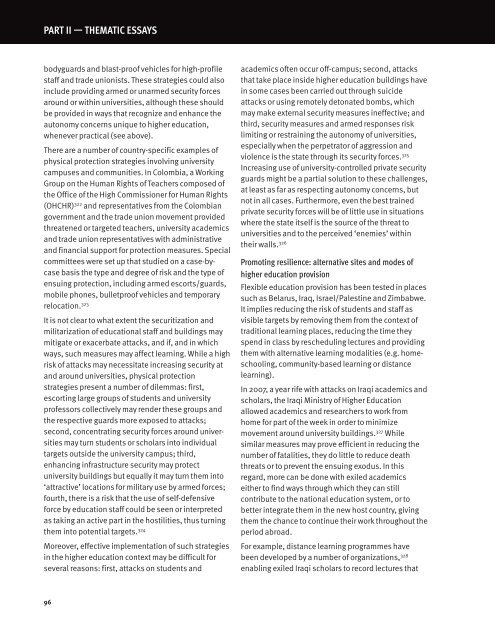eua_2014_full.pdf?utm_content=buffer4a392&utm_medium=social&utm_source=twitter
eua_2014_full.pdf?utm_content=buffer4a392&utm_medium=social&utm_source=twitter
eua_2014_full.pdf?utm_content=buffer4a392&utm_medium=social&utm_source=twitter
- No tags were found...
You also want an ePaper? Increase the reach of your titles
YUMPU automatically turns print PDFs into web optimized ePapers that Google loves.
PART II — THeMATIC eSSAYSbodyguards and blast-proof vehicles for high-profilestaff and trade unionists. These strategies could alsoinclude providing armed or unarmed security forcesaround or within universities, although these shouldbe provided in ways that recognize and enhance theautonomy concerns unique to higher education,whenever practical (see above).There are a number of country-specific examples ofphysical protection strategies involving universitycampuses and communities. In Colombia, a WorkingGroup on the Human Rights of Teachers composed ofthe Office of the High Commissioner for Human Rights(OHCHR) 322 and representatives from the Colombiangovernment and the trade union movement providedthreatened or targeted teachers, university academicsand trade union representatives with administrativeand financial support for protection measures. Specialcommittees were set up that studied on a case-bycasebasis the type and degree of risk and the type ofensuing protection, including armed escorts/guards,mobile phones, bulletproof vehicles and temporaryrelocation. 323It is not clear to what extent the securitization andmilitarization of educational staff and buildings maymitigate or exacerbate attacks, and if, and in whichways, such measures may affect learning. While a highrisk of attacks may necessitate increasing security atand around universities, physical protectionstrategies present a number of dilemmas: first,escorting large groups of students and universityprofessors collectively may render these groups andthe respective guards more exposed to attacks;second, concentrating security forces around universitiesmay turn students or scholars into individualtargets outside the university campus; third,enhancing infrastructure security may protectuniversity buildings but equally it may turn them into‘attractive’ locations for military use by armed forces;fourth, there is a risk that the use of self-defensiveforce by education staff could be seen or interpretedas taking an active part in the hostilities, thus turningthem into potential targets. 324Moreover, effective implementation of such strategiesin the higher education context may be difficult forseveral reasons: first, attacks on students andacademics often occur off-campus; second, attacksthat take place inside higher education buildings havein some cases been carried out through suicideattacks or using remotely detonated bombs, whichmay make external security measures ineffective; andthird, security measures and armed responses risklimiting or restraining the autonomy of universities,especially when the perpetrator of aggression andviolence is the state through its security forces. 325Increasing use of university-controlled private securityguards might be a partial solution to these challenges,at least as far as respecting autonomy concerns, butnot in all cases. Furthermore, even the best trainedprivate security forces will be of little use in situationswhere the state itself is the source of the threat touniversities and to the perceived ‘enemies’ withintheir walls. 326Promoting resilience: alternative sites and modes ofhigher education provisionFlexible education provision has been tested in placessuch as Belarus, Iraq, Israel/Palestine and Zimbabwe.It implies reducing the risk of students and staff asvisible targets by removing them from the context oftraditional learning places, reducing the time theyspend in class by rescheduling lectures and providingthem with alternative learning modalities (e.g. homeschooling,community-based learning or distancelearning).In 2007, a year rife with attacks on Iraqi academics andscholars, the Iraqi Ministry of Higher Educationallowed academics and researchers to work fromhome for part of the week in order to minimizemovement around university buildings. 327 Whilesimilar measures may prove efficient in reducing thenumber of fatalities, they do little to reduce deaththreats or to prevent the ensuing exodus. In thisregard, more can be done with exiled academicseither to find ways through which they can stillcontribute to the national education system, or tobetter integrate them in the new host country, givingthem the chance to continue their work throughout theperiod abroad.For example, distance learning programmes havebeen developed by a number of organizations, 328enabling exiled Iraqi scholars to record lectures that96


